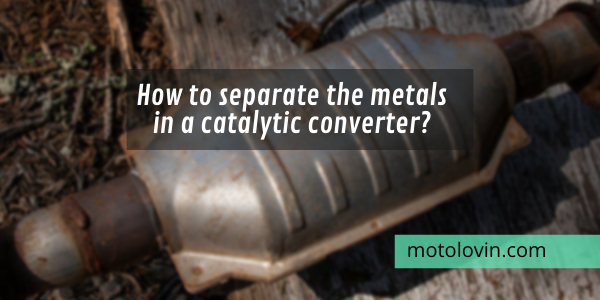Hola fellow automotive enthusiasts! Have you ever wondered what secrets lie within the intricate chambers of a catalytic converter? Beyond its role in reducing harmful emissions, this unassuming component houses a treasure trove of precious metals waiting to be uncovered. In this article, we will embark on a thrilling journey to demystify the process of separating these valuable metals. So, fasten your seatbelts, and let’s dive into the world of catalytic converter metallurgy!
How to separate the metals in a catalytic converter
Beneath its humble exterior, a catalytic converter conceals a wealth of precious metals, including platinum, palladium, and rhodium. These elements play a vital role in catalyzing chemical reactions, allowing pollutants to be converted into less harmful substances. However, extracting and separating these metals can be a daunting task. Fear not! We’re here to guide you through the process step by step, ensuring you reclaim every ounce of these hidden treasures.
Step 1: Deconstruction Delight: To begin the metal-reclaiming adventure, we must dismantle the catalytic converter. This entails carefully removing it from the vehicle and disassembling it. Take note of any safety precautions and ensure you’re equipped with the necessary tools. Once the converter is disassembled, you’ll be able to access the precious metal-laden catalyst.
Step 2: Crushing the Catalyst: Now that we have the catalyst in our hands, it’s time to break it down into smaller pieces. This can be achieved by crushing the catalyst using specialized equipment or even a hammer (gently, of course!). The goal here is to increase the surface area, making it easier for subsequent separation processes.
Step 3: Sizzling Separation: Heat becomes our ally as we move on to the separation stage. By subjecting the crushed catalyst to high temperatures in a controlled environment, we initiate thermal decomposition. This process breaks down the catalyst, releasing the precious metals from their molecular prisons.
Step 4: Magic of Magnetism: While not all precious metals in a catalytic converter are magnetic, some contain iron, which can be harnessed for separation. Utilizing the power of magnetism, pass a strong magnet over the crushed catalyst. The magnet will attract and separate any iron-containing metals, leaving behind the non-magnetic treasures.
Step 5: Refining the Riches: With the metals separated, it’s time to refine and purify them further. This step typically involves chemical processes such as leaching or solvent extraction. These techniques selectively dissolve the desired metals, leaving impurities behind. The resulting solution can then be further processed to isolate and recover the precious metals in their purest form.
Step 6: A Sustainable Future: As we explore the world of catalytic converter metallurgy, it’s essential to highlight the importance of sustainability. Recycling and reclaiming these precious metals not only offer a lucrative opportunity but also contributes to environmental conservation. By recovering and reusing these metals, we reduce the need for mining and minimize the impact on our planet.
Congratulations on reaching the end of our metal-separating journey! Remember, the process outlined here requires expertise, specialized equipment, and adherence to local regulations. If you’re considering extracting precious metals from a catalytic converter, we encourage you to consult professionals in the field. They can provide valuable guidance and ensure safe and efficient metal reclamation.
Precautions :
Before we dive into the nitty-gritty of separating metals in a catalytic converter, let’s take a moment to discuss some important precautions you should keep in mind. Safety should always be a top priority, and handling catalytic converters requires caution and adherence to best practices.
Protective Gear: When working with catalytic converters, ensure you have the appropriate personal protective equipment (PPE). This includes gloves, safety goggles, and a mask to protect against harmful particles and fumes. The metals within catalytic converters, as well as the chemicals used during the separation process, can pose health risks if proper precautions aren’t taken.
Ventilation: Adequate ventilation is crucial to minimize exposure to potentially toxic substances. Make sure you’re working in a well-ventilated area, preferably outdoors or in a space equipped with proper exhaust systems. Avoid working in confined spaces where fumes can accumulate.
Legal Considerations: Before embarking on any activities related to catalytic converters, familiarize yourself with local laws and regulations. In some jurisdictions, there may be restrictions or requirements for handling and recycling these components. Compliance with environmental regulations is essential to ensure both your safety and the protection of the environment.
Professional Assistance: While the process of separating metals in a catalytic converter can be intriguing, it’s important to recognize that it requires expertise and specialized equipment. If you’re a beginner or lack experience in this field, seeking the guidance of professionals is highly recommended. They can provide valuable insights, ensure compliance with regulations, and assist you in navigating the intricacies of metal reclamation.
Environmental Impact: As we strive to reclaim precious metals, let’s not forget our responsibility to the environment. Improper disposal of hazardous waste, including unused catalysts or chemicals, can have detrimental effects on ecosystems. Always follow environmentally friendly practices and consider recycling options for any byproducts generated during the metal separation process.
By keeping these precautions in mind, you’ll not only safeguard yourself but also contribute to a safer and more sustainable approach to working with catalytic converters. Remember, knowledge and responsible practices go hand in hand when it comes to any automotive endeavor.
So, whether you’re a car enthusiast seeking hidden treasures or an environmental advocate promoting sustainability, the world of catalytic converter metallurgy offers both excitement and responsibility. Let’s continue to explore innovative ways to harness these precious metals while safeguarding our planet for generations to come. Happy metal separating!
